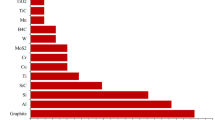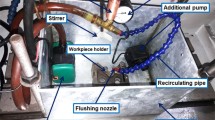Abstract
Present study investigates the feasibility of improving surface characteristics in the micro-electric discharge machining (EDM) of cemented tungsten carbide (WC–Co), a widely used die and mould material, using graphite nano-powder-mixed dielectric. In this context, a comparative analysis has been carried out on the performance of powder-mixed sinking and milling micro-EDM with view of obtaining smooth and defect-free surfaces. The surface characteristics of the machined carbide were studied in terms of surface topography, crater characteristics, average surface roughness (R a) and peak-to-valley roughness (R max). The effect of graphite powder concentration on the spark gap, material removal rate (MRR) and electrode wear ratio (EWR) were also discussed for both die-sinking and milling micro-EDM of WC–Co. It has been observed that the presence of semi-conductive graphite nano-powders in the dielectric can significantly improve the surface finish, enhance the MRR and reduce the EWR. Both the surface topography and crater distribution were improved due to the increased spark gap and uniform discharging in powder-mixed micro-EDM. The added nano-powder can lower the breakdown strength and facilitate the ignition process thus improving the MRR. However, for a fixed powder material and particle size, all the performance parameters were found to vary significantly with powder concentration. Among the two processes, powder-mixed milling micro-EDM was found to provide smoother and defect-free surface compared to sinking micro-EDM. The lowest value of R a (38 nm) and R max (0.17 μm) was achieved in powder-mixed milling micro-EDM at optimum concentration of 0.2 g/L and electrical setting of 60 V and stray capacitance.
Similar content being viewed by others
References
Casas B, Torres Y, Llanes L (2006) Fracture and fatigue behavior of electrical discharge machined cemented carbides. Int J Refract Met Hard Mater 24:162–167
Koshy P, Jain VK, Lal GK (1997) Grinding of cemented carbide with electrical spark assistance. J Mater Process Technol 72:61–68
Ramasawmy H, Blunt L (2002) 3D surface topography assessment of the effect of different electrolytes during electrochemical polishing of EDM surfaces. Int J Mach Tools Manuf 42:567–574
Wong YS, Lim LC, Rahuman I, Tee WM (1998) Near-mirror-finish phenomenon in EDM using powder-mixed dielectric. J Mater Process Technol 79:30–40
Erden A, Bilgin S (1980) Role of impurities in electric discharge machining. In Proceedings of 21st International Machine Tool Design and Research Conference, Macmillan, London, pp. 345–350
Jeswani ML (1981) Effects of the addition of graphite powder to kerosene used as the dielectric fluid in electrical discharge machining. Wear 70:133–139
Narumiya H, Mohri N, Saito N, Otake H, Tsnekawa Y, Takawashi T, Kobayashi K (1989) EDM by powder suspended working fluid. In Proceedings of 9th ISEM, pp. 5–8
Mohri N, Saito N, Higashi MA (1991) A new process of finish machining on free surface by EDM methods. Ann CIRP 40(1):207–210
Kobayashi K, Magara T, Ozaki Y, Yatomi T (1992) The present and future developments of electrical discharge machining. In Proceedings of 2nd International Conference on Die and Mould Technology, Singapore, pp. 35–47
Yan BH, Chen SL (1994) Characteristics of SKD11 by complex process of electric discharge machining using liquid suspended with aluminum powder. J Jpn Inst Light Met 58(9):1067–1072
Uno Y, Okada A (1997) Surface generation mechanism in electrical discharge machining with silicon powder mixed fluid. Int J Elec Mach 2:13–18
Wang CH, Lin YC, Yan BH, Huang FY (2001) Effect of characteristics of added powder on electric discharge machining. J Jpn Inst Light Met 42(12):2597–2604
Tzeng YF, Lee CY (2001) Effects of powder characteristics on electro discharge machining efficiency. Int J Adv Manuf Technol 17:586–592
Pecas P, Henriques EA (2003) Influence of silicon powder mixed dielectric on conventional electrical discharge machining. Int J Mach Tools Manuf 43:1465–1471
Kung KY, Horng JT, Chiang KT (2009) Material removal rate and electrode wear ratio study on the powder mixed electrical discharge machining of cobalt-bonded tungsten carbide. Int J Adv Manuf Technol 40:95–104
Chow HM, Yan BH, Huang FY, Hung JC (2000) Study of added powder in kerosene for the micro-slit machining of titanium alloy using electro-discharge machining. J Mater Process Technol 101:95–103
Tan PC, Yeo SH, Tan YV (2008) Effects of nano-sized powder additives in micro-electrical discharge machining. Int J Precis Eng Manuf 9(3):22–26
Jahan MP, Anwar MM, Wong YS, Rahman M (2009) Nanofinishing of hard materials using micro-EDM. Proc IMechE, Part B: J Engineering Manufacture 223(9):1127–1142
Jahan MP, Wong YS, Rahman M (2009) A study on the fine-finish die-sinking micro-EDM of tungsten carbide using different electrode materials. J Mater Process Technol 209:3956–3967
Jahan MP, Wong YS, Rahman M (2009) Effect of non-electrical and gap control parameters in the micro-EDM of WC-Co. J Mach Form Technol 1/2:51–78
Jahan MP, Wong YS, Rahman M (2009) A study on the quality micro-hole machining of tungsten carbide by micro-EDM process using transistor and RC-type pulse Generator. J Mater Process Technol 209(4):1706–1716
Lee SH, Li XP (2001) Study of the effect of machining parameters on the machining characteristics in EDM of tungsten carbide. J Mater Process Technol 115:344–355
Tzeng YF, Chen FC (2005) Investigation into some surface characteristics of electrical discharge machined SKD-11 using powder-suspension dielectric oil. J Mater Process Technol 170:385–391
Jahan MP, Wong YS, Rahman M (2010) A comparative experimental investigation of deep-hole micro-EDM drilling capability for cemented carbide (WC-Co) against austenitic stainless steel (SUS 304). Int J Adv Manuf Technol 46(9–12):1145–1160
Yan BH, Huang FY, Chow HM, Tsai JY (1999) Micro-hole machining of carbide by electrical discharge machining. J Mater Process Technol 87:139–145
Wu KL, Yan BH, Huang FY, Chen SC (2005) Improvement of surface finish on SKD steel using electro-discharge machining with aluminum and surfactant added dielectric. Int J Mach Tools Manuf 45:1195–1201
Bleys P, Kruth JP, Lauwers B, Schacht B, Balasubramanian V, Froyen L, Humbeeck JV (2006) Surface and sub-surface quality of steel after EDM. Adv Eng Mater 8:15–25
Kansal HK, Singh S, Kumar P (2007) Technology and research developments in powder mixed electric discharge machining (PMEDM). J Mater Process Technol 184:32–41
Amorim FL, Weingaertner WL (2005) The influence of generator actuation mode and process parameters on the performance of finish EDM of tool steel. J Mater Process Technol 166:411–416
Author information
Authors and Affiliations
Corresponding author
Rights and permissions
About this article
Cite this article
Jahan, M.P., Rahman, M. & Wong, Y.S. Study on the nano-powder-mixed sinking and milling micro-EDM of WC-Co. Int J Adv Manuf Technol 53, 167–180 (2011). https://doi.org/10.1007/s00170-010-2826-9
Received:
Accepted:
Published:
Issue Date:
DOI: https://doi.org/10.1007/s00170-010-2826-9




